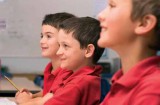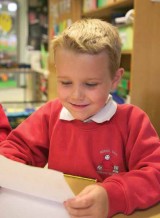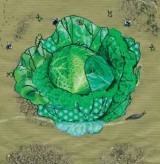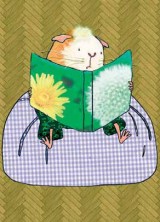Christopher Nibble's tale of dandelion derring-do is a delightful starting point for a KS1 topic, says Judy Clark...
 I would probably have bought this book just for its title; Christopher Nibble in a tale of dandelion derring- do! Just the mention of derring -do and the mental image of a brave young guinea pig on an adventure and, sadly, I was hooked. Pleasingly, once you open the book it does not disappoint. It will delight your KS1 pupils and keep them engaged in cross curricular literacy for weeks on end.
I would probably have bought this book just for its title; Christopher Nibble in a tale of dandelion derring- do! Just the mention of derring -do and the mental image of a brave young guinea pig on an adventure and, sadly, I was hooked. Pleasingly, once you open the book it does not disappoint. It will delight your KS1 pupils and keep them engaged in cross curricular literacy for weeks on end.
The tale follows events in the town of Dandeville, where not only Christopher and the Nibble family, but also the entire town are extremely fond of the local delicacy… dandelions of course
Unfortunately, rampant consumerism leads to the once plentiful crop disappearing and the worse thing imaginable happens; they are left with only chewy cabbages to eat. Yuk! That is until Christopher comes to the rescue. Outside his bedroom window grows the last ever dandelion and the rest of the book follows his quest to restore the town’s favorite food and with it the balance of nature.
As you and the children delve into Dandeville, you will discover that Christopher Nibble is one of those brilliant books where every image and page conjures up opportunities for response in so many different ways you will be spoilt for choice.
 Such an underused form of writing and vital in helping developing writers explore words, ideas and sentences, poetry should be weaved and embedded into teaching and learning as often as possible. In the opening pages of the book we are introduced to the town of Dandeville and the lives of its guinea pig population. The main pastime, it would seem, is munching and nibbling – already two wonderfully sounding words.
Such an underused form of writing and vital in helping developing writers explore words, ideas and sentences, poetry should be weaved and embedded into teaching and learning as often as possible. In the opening pages of the book we are introduced to the town of Dandeville and the lives of its guinea pig population. The main pastime, it would seem, is munching and nibbling – already two wonderfully sounding words.
Generate a storm of ideas with the children about the sounds they might hear walking through the town’s streets. Perhaps the clinking of glasses as they sip dandelion juice in the warm sun, the slurping of dandelion soup from the local restaurant, the crunching of dandelion cookies.
Using a poem as a model is a super way to scaffold children’s own writing and, of course, Roger McGough’s Sound Collector would be a perfect poem to enjoy and use to create your own class poem together.
A visitor entered Dandeville
Along the daisy track
He put every sound that he
could hear
Into a large green sack
...and off you head into a super list poem of all those sounds you have collected together.
 Charlotte Middleton’s illustrations are superb and have such a sense of humor which makes them so engaging for children. I love the snapshot of what happens in the town when the dandelions run out, as the local restaurant menus need to be changed, with sold out signs everywhere and new varieties of products being introduced in their place; what appears to be beetroot jam and carrot juice!
Charlotte Middleton’s illustrations are superb and have such a sense of humor which makes them so engaging for children. I love the snapshot of what happens in the town when the dandelions run out, as the local restaurant menus need to be changed, with sold out signs everywhere and new varieties of products being introduced in their place; what appears to be beetroot jam and carrot juice!
Why not create an entire restaurant area in the classroom complete with table cloths, place settings, menus and a specials board? The children could roleplay the heyday of dandelions and be assigned individual roles, such as waiter, cook, maitre d’, and a whole range of different types of customer. Then it will be all change as the dandelions run out and the class could set about creating new menus using all of the vegetables they don’t like.
 Some budding Jamie Olivers may want to create and concoct interesting meals with dandelions, which of course will require shopping lists of ingredients to be written along with recipes.
Some budding Jamie Olivers may want to create and concoct interesting meals with dandelions, which of course will require shopping lists of ingredients to be written along with recipes.
Picnics seem to be a popular past time in Dandeville, which provides yet more role-play opportunities as children recreate the picnic scene from the book with all its culinary delights. Water with green food colouring makes wonderful looking dandelion juice. Of course, they may have to organise their own picnic, which will mean more lists of things they will need and the creation of another shopping list. It’s great to give children a list of available items with prices they can find at the shop, then give them a set amount of money and ask them to work out which key items they can afford to purchase.
The fantastic image of a guinea pig in front of the internet bidding on one of the last remaining leaves in existence is a joy.
Children are immersed in advertising. Explore the image with the children and the techniques used to grab a buyer’s attention online; the font, use of the exclamation mark, visuals, details, ease of buying method and, of course, persuasive language, i.e. ‘the organic, juicy dandelion’. Children can then create their own adverts, posters or web pages.
In light of a lack of dandelions, there will be a real need for adverts for new products. Children can design and create a new product to sell and even script and film their own M&S style advert: “This is no ordinary pumpkin jelly; this is Dandeville pumpkin jelly.”
 Christopher faces a dilemma. He absolutely loves dandelions and there, outside his bedroom window, is what might be the last one. Nobody knows he has it. He could eat it all by himself and no one would know.
Christopher faces a dilemma. He absolutely loves dandelions and there, outside his bedroom window, is what might be the last one. Nobody knows he has it. He could eat it all by himself and no one would know.
When reading the book with the children it is the perfect time to start thinking about Christopher’s character and what they think he should do at this point. Hot seating the poor guinea pig in his moment of decision would be ideal. You could use a conscience alley to explore for and against devouring the plant, and wider discussions with the children about truth and honesty will also present themselves.
The tale is an allegory of consumerism which can be explored with the children. The environmental theme can be further developed by using other books; Where the Forest Meets the Sea by Jeannie Baker, One World by Michael Foreman and Sally and the Limpet by Simon James would be some of my favourites.
 Discussion with the children about what Christopher should do will hopefully mirror his actual decision: to find out all he can about dandelions. And where does he go? The library of course. The library book titles range from cookery best sellers such as Jamie Cauliflower and Ready, Steady, Nibble! to the more easily recognisable The Very Hungry Guinea Pig! From here, along with Christopher, the children can learn all about how to look after and grow dandelions, meaning there are opportunities for science work and writing abound.
Discussion with the children about what Christopher should do will hopefully mirror his actual decision: to find out all he can about dandelions. And where does he go? The library of course. The library book titles range from cookery best sellers such as Jamie Cauliflower and Ready, Steady, Nibble! to the more easily recognisable The Very Hungry Guinea Pig! From here, along with Christopher, the children can learn all about how to look after and grow dandelions, meaning there are opportunities for science work and writing abound.
So many more activities an be explored across the curriculum…
1. You could create an aerial map of Dandeville or become town planners and build a scale model of key landmarks in the town. What types of shops would there be? What other facilities might they have? We know there is a library and a restaurant. Let children choose where Christopher’s house would be, where they think Daisy Chain Hill is or the football pitch where Christopher loves to play.
2. No doubt someone in school will have a pet guinea pig at home who may like to come in and visit the children. This is a perfect opportunity for some observational poetry or an ‘ask the expert’ session.
3. Middleton’s illustrations use an unusual mixed media approach with photo-collage of fabric, scene and objects woven within the pages. One of the most obvious examples is the central picture of the nightmare chewy cabbage. Explore this approach with the children by letting them choose from a range of photos of different vegetables, remove a section and let the children fill in the missing area seamlessly with line drawing. Children can also create colorful dandelion landscapes using dandelion heads as paintbrushes, or wrapping paper with a dandelion pattern.
4. Children could conduct experiments on what makes a dandelion grow, or ‘to cloche or not to cloche’! There are some excellent web based activities to help support children’s science (bbc.co.uk/schools/scienceclips/ages/5_6/growing_plants.shtml).
Judy Clark is talk for writing adviser for the National Literacy Trust. She has worked alongside Pie Corbett to develop Talk for Writing in practice and deliver training to schools.
Should you let educational researchers into your classroom?
Ace-Classroom-Support
How To Use Books To Help Children Cope With Life
Ace-English
Help Pupils Tell Fact From Fiction In The Digital World
Ace-Computing
Top tips for differentiation
Ace-Maths
